Last updated on February 2nd, 2024
Our site is reader supported, this means we may earn a small commission from Amazon and other affiliates when you buy through links on our site.
Magnolias come in one of two forms, that of a shrub or a tree, and are either evergreen or deciduous. However more often in the UK, you see the deciduous varieties such as Stellata and Susan. Ideally, they should be planted in autumn, winter or spring and will flower in spring or summer.
The average Magnolia will reach a height between 2 and 3 metres, although they can grow as tall as 15 metres, with a spread between 10 metres for old established tree-types often seen in country gardens. They can do well in sun or partial shade in a sheltered position and are fully hardy producing a massive show of spectacular flowers in early spring when not much else is flowering, as pictured below.
Choosing the right variety of Magnolia
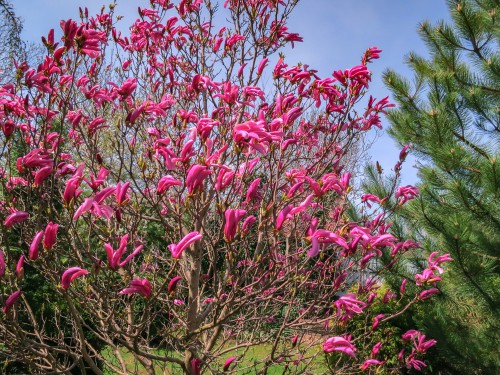
Choosing the right variety comes down to where you want to put the Magnolia in your garden. You can choose between evergreen and deciduous varieties, which vary in terms of their size and when you can prune. Picking the right variety is going to help you make the most out of the soil you have in your garden and the amount of sun exposure your garden receives on a regular basis.
Follow the guidelines below to pick a Magnolia variety that will work best for your garden. For most people, you are going to plant, or already have, one of the more common deciduous varieties so let’s get started.
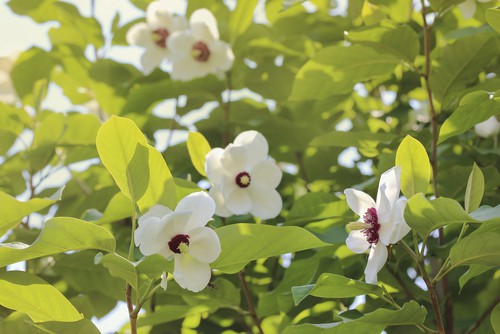
Quick Recommendations
- If you have dry, alkaline soil you should consider varieties such as Magnolia grandiflora and Magnolia delavayi. Both of these are evergreen varieties.
- If you have alkaline soil that is very moist, you can grow Magnolia × loebneri, Magnolias seiboldii, Magnolia stellata and the Magnolia wilsonii successfully.
- If you have particularly wet soil, the Magnolia grandiflora and Magnolia virginiana are the most tolerant. These varieties tolerate sheltered sites but they grow best if they have a warm wall against which they can grow. These two will not thrive in particularly cold areas where the temperature has dropped below -5°C which means they’re better suited for gardens further south of the UK. A heavy frost will damage the flowers and the foliage. The Magnolia grandiflora, in particular, will not tolerate heavy winds and will need to be staked when you plant it, even if it is fully mature.
- If you have an area with dappled shade, you are better off picking a late flowering specimen of deciduous Magnolia like Magnolia wilsonii and Magnolia sieboldii.
Planting Magnolias
Before you plant your Magnolia, you should find an area that has full sun and moist soil conditions. Many people will plant evergreen Magnolias against a wall, training it to grow up against the wall, without any damage to the structure. If you prefer there are some Magnolia varieties that can be cultivated in large containers and pots.
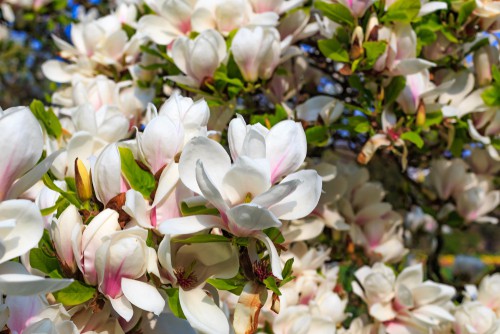
Where to grow Magnolias
Where you grow your Magnolias is really contingent upon the variety you have. As mentioned most of them need good sun exposure and well-drained soil, and as long as you pick up variety that matches the pH level of your soil, you can pretty much grow them anywhere. If you don’t have space in the ground to plant Magnolias or perhaps you want a very specific variety but your pH level will not tolerate it, you can always grow Magnolias in pots and then place the containers where you see fit.
Magnolia General Care
Feeding and watering
Magnolias require very little effort in terms of general care. The biggest thing to be aware of is over-watering, and if you see issues with flowering you can always add a light fertiliser. Follow any instructions for the fertiliser you have selected and apply accordingly. New plants need to be more heavily watered for the first few months as they get themselves established in your garden. Once they are well-rooted you can reduce the amount that you water and care in general unless you are growing them in containers.
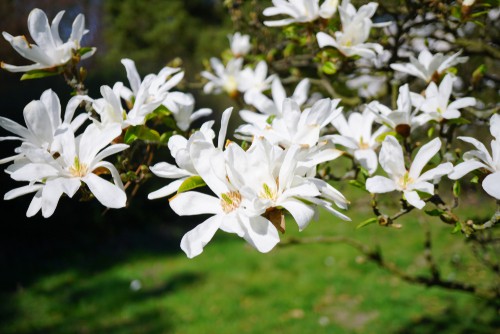
Training evergreen varieties against a wall
If you have an evergreen Magnolia, especially the grandiflora variety, it’s best to train the Magnolia against a wall that enjoys full sun exposure. To do this you want to tie the shoots of the tree at a 45-degree angle to a support structure or to the wires you have in place. Then lower them to a horizontal position the following season.
Regularly pruning an evergreen Magnolia that you are training against the wall can help remove shoots that are growing towards your wall and reduces the outward growing shoots until they have just one or two sets of leaves. If you allow the outward growing shoots to reach the point of flowering buds, you have to delay pruning until right after flowering has finished.
Pruning
Pruning is really where you have to exercise the most care. If you have a deciduous Magnolia you really shouldn’t be pruning much at all. When you first plant a deciduous variety you can shape your tree by removing any badly placed stems or weak shoots.
With the deciduous varieties, too much pruning, or heavy pruning, can cause what is called water shoots from low down. Water shoots are vertical, vigorous shoots that develop and then die back. You don’t want this. Instead you should routinely prune any dead wood or water shoots that you see as they develop. Pruning should only really be done to maintain a good shape and framework.

When to prune deciduous varieties
Do not prune them at the end of winter or spring because this will cause the cuts to bleed. Only prune the deciduous Magnolias from the middle of summer until the beginning of autumn, ideally after flowering. If you have a limited space in which your Magnolia can grow and you need to prune it back, try to thin out the stems to the point of the trunk keeping an open, balanced crown and, most importantly, don’t do it all at once. If you know that your Magnolia is starting to outgrow its space, stagger your pruning over the next several years, taking a little bit each year so that you don’t overly stress the plant.
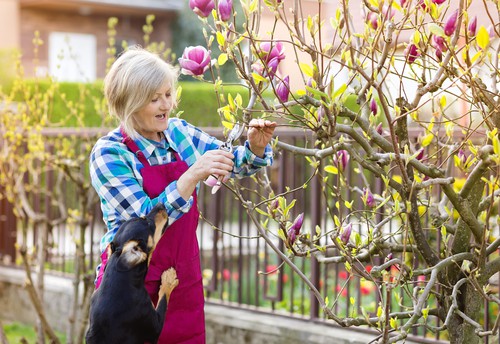
Pruning evergreen varieties
The evergreen Magnolias are slightly more tolerant of pruning. You can prune the lengthy, young branches when you have a new tree, which is also the perfect time to remove the lower branches if you want to create a bare stem and a more traditional tree shape. Much the same as the deciduous varieties, hard pruning can be tolerated but shouldn’t be done all at once. If your Magnolia has been damaged or is in need of serious rejuvenation, cut back to the main framework but spread out the total pruning over the span of several years. Do it only in the spring as the new growth begins, unless you have your specimen trained against a wall in which case you should prune in the summer.
You can learn more about pruning Magnolias here
Propagating
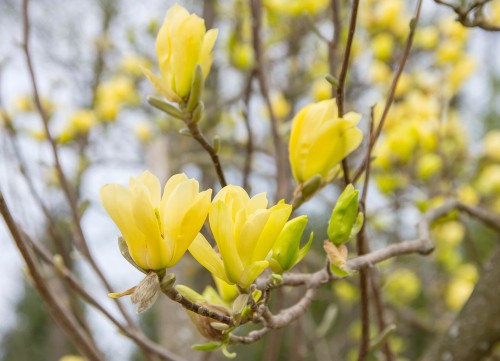
Layering and taking cuttings
You can layer the shoots near the ground level to propagate from an existing tree. This is one of the easiest methods for propagating. If you have a deciduous Magnolia you can propagate it using semi-hardwood cuttings. Take the cuttings and overwinter them so that they can become fully developed in time to pot on the following year. If you have an evergreen Magnolia you should take a semi-ripe cutting at the end of summer or the beginning of autumn.
Growing from seed
Theoretically, you can grow a Magnolia from seed but it will take well over 10 years to start flowering so it’s usually not recommended. The seeds have to be collected when the cone starts to split and then properly cleaned and mixed with moist sand for an average of 4 months in the refrigerator.
Realistically any of these propagating methods are going to take quite some time, not just to do successfully but to produce a flowering Magnolia, so if you truly want a Magnolia somewhere else in your garden, it’s best that you purchase a slightly more mature plant so that you can enjoy the flowers much sooner, however, it’s also fun to try and take a few cuttings or try your hand at layering.
Learn more about propagating magnolias
Magnolia Problems
In terms of pests and other problems, one of the biggest issues Magnolia owners face is non-flowering. If you have a newly planted young shrub and it is not producing flowers, rest assured it can take several years for a new tree to settle into your garden before it produces flowers.
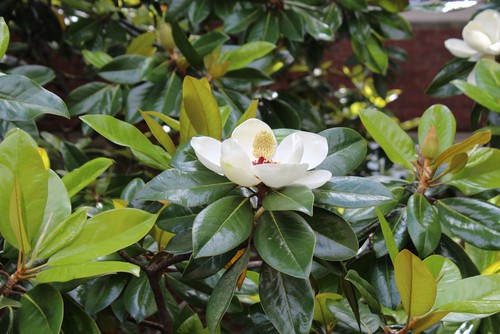
Non-flowering caused by excessive pruning
If your tree is established and it has been in your garden for quite some time, non-flowering could be a reflection of either excessive pruning the previous year or an inadequate growing position. Certain varieties (like the grandiflora) need warm, sunny conditions to flower so if you accidentally planted it somewhere that doesn’t get enough sun, you might not get flowers. Similarly, if you prune your Magnolia too much it can influence the number of flowers you receive.
Loss of leaves in evergreen varieties
If your Magnolia is an evergreen variety and you’ve had it for several years, it is quite normal to see some of the leaves falling off at the beginning of summer. You can learn more about why magnolias drop there leaves in this guide
Frost damage causing buds to turn black or drop
Other issues you might see are blackened flowers or blackened buds. This is a result of frost damage. So if you have a particularly cold winter and some of your early flower buds or flowers are damaged by a cold snap, they can turn black. You can simply deadhead these and wait for warmer weather to bring better flowers.
Yellowing leaves
If the young leaves on your Magnolia are yellow, this is perfectly normal. Younger leaves have a pale appearance but if you have a more mature plant and you are seeing yellow leaves that is indicative of too much alkalinity in the soil.
Other Problems
Other issues you might find with your Magnolia are brown leaves, root rot or honey fungus. These are things caused by inadequate air circulation, too much water or improper drainage, and can be tackled by transplanting the Magnolias, lightly pruning, or adding components to the soil to help with drainage, such as digging gravel into the soil. This should ideally be done before planting if the soil is prone to waterlog.
Magnolias are a stunning addition to any garden and make a beautiful display in late winter and the beginning of spring when the sun hits the flowers just right. By following these instructions for general maintenance and making sure that you plant your Magnolias in the appropriate locations, you can have a long-lasting plant for years to come.


